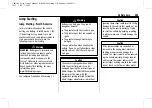
Cadillac Lyriq Owner Manual (GMNA-Localizing-U.S./Canada-15644413) -
2023 - CRC - 7/28/22
274
Vehicle Care
Sidewall
:
The portion of a tire between
the tread and the bead.
Speed Rating
:
An alphanumeric code
assigned to a tire indicating the
maximum speed at which a tire can
operate.
Traction
:
The friction between the tire
and the road surface. The amount of
grip provided.
Tread
:
The portion of a tire that comes
into contact with the road.
Treadwear Indicators
:
Narrow bands,
sometimes called wear bars, that show
across the tread of a tire when only
1.6 mm (1/16 in) of tread remains. See
.
UTQGS (Uniform Tire Quality Grading
Standards)
:
A tire information system
that provides consumers with ratings
for a tire's traction, temperature, and
treadwear. Ratings are determined by
tire manufacturers using government
testing procedures. The ratings are
molded into the sidewall of the tire.
See
.
Vehicle Capacity Weight
:
The number
of designated seating positions
multiplied by 68 kg (150 lbs) plus the
rated cargo load. See
Vehicle Maximum Load on the Tire
:
Load on an individual tire due to curb
weight, accessory weight, occupant
weight, and cargo weight.
Vehicle Placard
:
A label permanently
attached to a vehicle showing the
vehicle's capacity weight and the
original equipment tire size and
recommended inflation pressure. See
“
Tire and Loading Information Label
”
under
Tire Pressure
Tires need the correct amount of air
pressure to operate effectively.
{
Warning
Neither tire underinflation nor
overinflation is good. Underinflated
tires, or tires that do not have
enough air, can result in:
.
Tire overloading and overheating,
which could lead to a blowout
.
Premature or irregular wear
.
Poor handling
.
Reduced fuel economy for
internal combustion engine
vehicles
.
Reduced range for electric vehicles
Overinflated tires, or tires that have
too much air, can result in:
.
Unusual wear
.
Poor handling
.
Rough ride
.
Needless damage from road
hazards






























